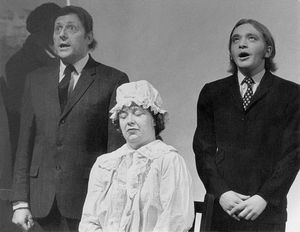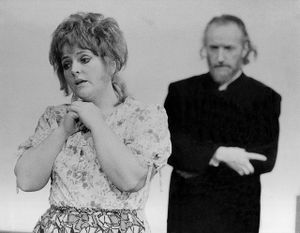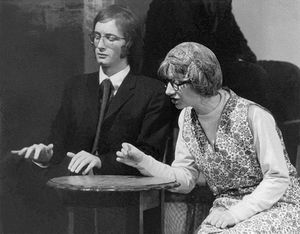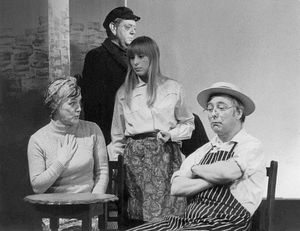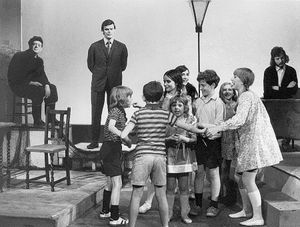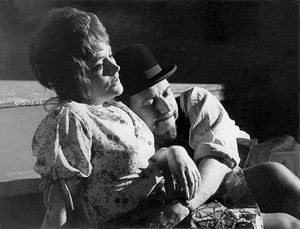Difference between revisions of "Under Milk Wood (1972)"
(→Gallery) |
(→Gallery) |
||
| (5 intermediate revisions by the same user not shown) | |||
| Line 71: | Line 71: | ||
== Gallery == | == Gallery == | ||
<gallery widths="300px" heights="300px" perrow="5"> | <gallery widths="300px" heights="300px" perrow="5"> | ||
| − | Image: | + | Image:UMWood001.jpg |
Image:UnderMilkwood001.jpg | Image:UnderMilkwood001.jpg | ||
| + | Image:UMWood003.jpg | ||
| + | Image:UMWood002.jpg | ||
Image:UMWood004.jpg | Image:UMWood004.jpg | ||
| − | Image:UMWood005.jpg | + | Image:UMWood005.jpg |
</gallery> | </gallery> | ||
| Line 80: | Line 82: | ||
It is now though by some that the title came from the local road Milkwood Road in Herne Hill. Welsh artist Michael Edmonds, recalled that Dylan shared a house with fellow painter Alfred Janes on Milkwood Road in Herne Hill. Dylan’s friend, sculptor and London Welsh rugby player, Evan Samuel, is also recorded as stating, “Dylan used to come to watch the London Welsh games, and when, after the match, the teams would gather, as rugger clubs do, for a few pints at the old Half Moon Hotel at Herne Hill, Dylan would be there adding lustre to the gathering. He was a great conversationalist”. | It is now though by some that the title came from the local road Milkwood Road in Herne Hill. Welsh artist Michael Edmonds, recalled that Dylan shared a house with fellow painter Alfred Janes on Milkwood Road in Herne Hill. Dylan’s friend, sculptor and London Welsh rugby player, Evan Samuel, is also recorded as stating, “Dylan used to come to watch the London Welsh games, and when, after the match, the teams would gather, as rugger clubs do, for a few pints at the old Half Moon Hotel at Herne Hill, Dylan would be there adding lustre to the gathering. He was a great conversationalist”. | ||
| + | |||
| + | Others think this is unlikely saying the London Welsh used the Commercial in Railton Road, which until recently had many rugby shorts on display on the walls. | ||
== See Also == | == See Also == | ||
Latest revision as of 09:23, 13 October 2021

by Dylan Thomas
Designed & Directed by Eileen Raymond
Performances: Sun 4th – Sat 10th June 1972, Theatre
Contents
Introduction
From dawn to dusk you meet the 60 odd characters, who make up the town of Llareggub, from Mrs Ogmore-Pritchard and her two “abused” husbands to Dai Bread and his two wives. There is Lily Smalls, “Mrs Beynon’s treasure” and Mae West Cottage whose aim is to “sin until she blows up”. There are the sinister Pughs and gossipy Willy Nilly the postman. At the heart of the play is blind Captain Cat listening to the town and dreaming of his past life at sea and his lost loves, Polly Garter remembering her past lovers whilst “comforting” the living and Rosie Probert, who died long ago. There are the musical problems of Mr and Mrs Organ Morgan and the hilarious drinking problems of the Mr and Mrs Cherry Owens. We eavesdrop on the secret passions of Miss Myfanwy Price and Mr Mog Edwards. During a single tranquil, spring day fantasy and fact blend into a bewitching mixture.
Cast
- Bernard Bullbrook
- Janice Grady
- Susan Hartridge
- Wendy Issatt
- Ray Jones
- John Kennedy
- Leslie Lidyard
- Sheila Looker
- James Lyne
- Matthew Lyne
- Pamela Lyne
- Ann Mattey
- David Mattey
- Jayne Mattey
- Michael Mattey
- Michael Mawby
- Sylvia Meek
- Lesley Morris
- Eileen Nelson
- Raymond Nelson
- Ivy Oram
- Clare Palmer
- Dennis Picot
- Glyn Putwain
- Sheila Rees
- Jennifer Richards
- Malcolm Saunders
- Victor Shaw
- Ruth Shettle
- Arthur Skinner
- Clarence Llewellyn-Smith
- Edwin Stone
- Delia Tait
- Malcolm Woodman
- Anne Woolhouse
Crew
- Stage Manager - Brian Field
- Assistant Stage Managers - Sandra Gillon & Denise Woodford
- Lighting Control - Tony Rapson
- Sound Recording & Control - Jim Judd & Vera Amato
- Guitarist - Bernard Bullbrook
- Set Construction & Painting - D'Auvergne Barnard, Margaret Barnard & Paul Beech
- Wardrobe - Valerie White
- F.O.H. Manager - Frank Howcutt
- Photographs - B.I.M. Harding
- Programme Design - David Marchant
Reviews
Some review quotes go here
Gallery
Reminiscences and Anecdotes
It is now though by some that the title came from the local road Milkwood Road in Herne Hill. Welsh artist Michael Edmonds, recalled that Dylan shared a house with fellow painter Alfred Janes on Milkwood Road in Herne Hill. Dylan’s friend, sculptor and London Welsh rugby player, Evan Samuel, is also recorded as stating, “Dylan used to come to watch the London Welsh games, and when, after the match, the teams would gather, as rugger clubs do, for a few pints at the old Half Moon Hotel at Herne Hill, Dylan would be there adding lustre to the gathering. He was a great conversationalist”.
Others think this is unlikely saying the London Welsh used the Commercial in Railton Road, which until recently had many rugby shorts on display on the walls.
See Also
- Under Milk Wood (1991) (Prompt Corner)
- Under Milk Wood (2004) (Prompt Corner)
References
<references/>
